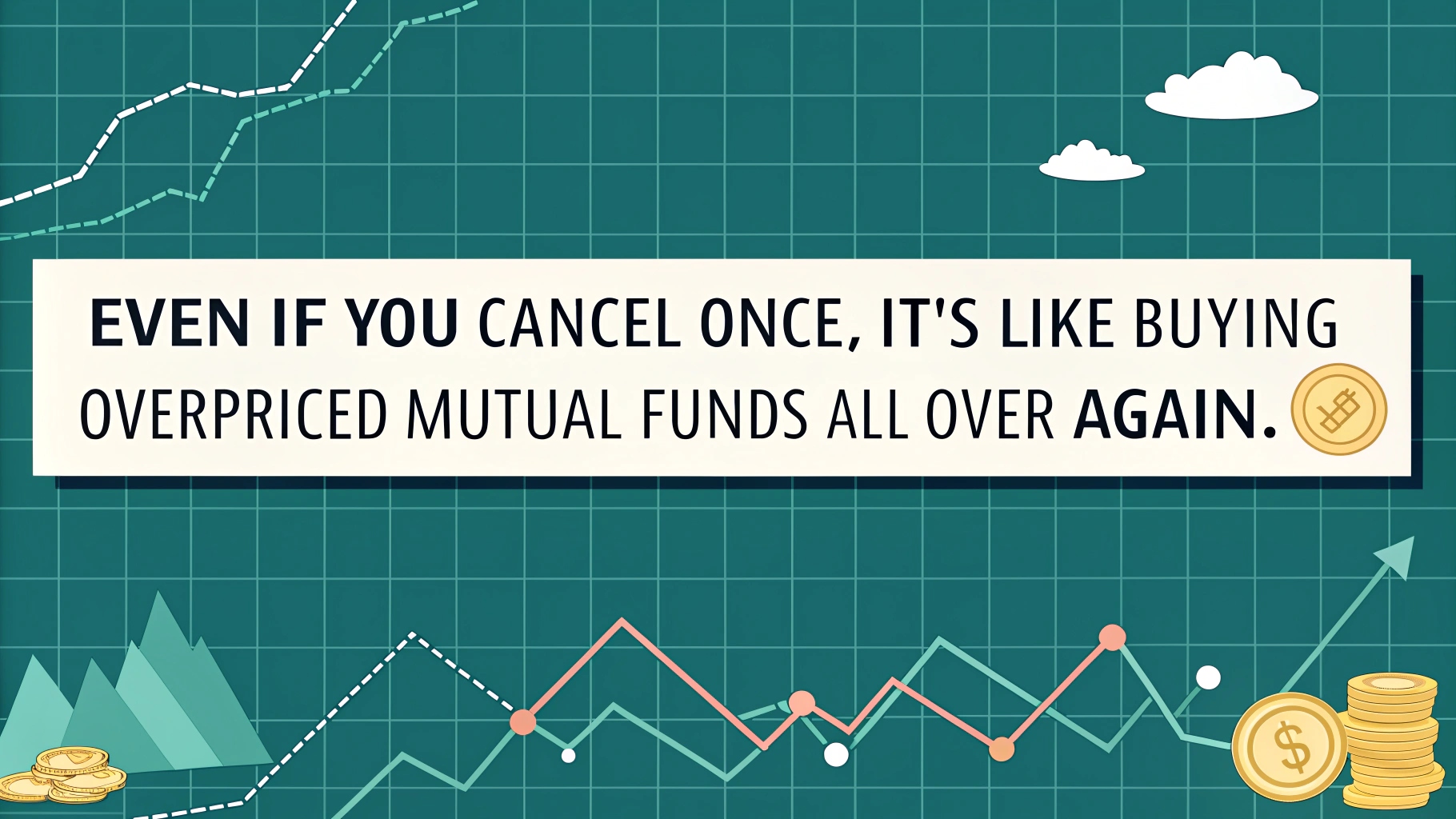「機会損失|保険は保険、投資は投資!まぜるなキケン!」
〜前回のつづき〜
●解約金で支払い、結局損をするかもしれない。

一時支払い保険料とは
全保険期間分の1回で支払う方法の事で
要はまとめて支払っちゃうという事です。
だから毎月の支払いは
発生しないんですよね。
今回の場合だったら
解約したら返ってくる
この110万円を
一時払いの支払いに
充てるんですよね。
一括で払っちゃう。
この110万円を元にして
新しい保険の契約ではないんですけど
新しい保険を契約するみたいな
イメージを持ってもらったら
丁度いいかと思います。

契約内容の変更なので
新規の契約ではない。
でもその方がイメージ的には
わかりやすいかと思います。
契約内容を変更するので
残り15年経ったら
110万円が
130万円とかになったりして
返ってくるんですよ。
解約して帰ってきたお金で
保証額の少ないものに変更するので
掛け捨て保険では無理なんですよ。
・養老保険
・学資保険
・個人年金
など色々あるんですけど
貯蓄性のある保険にしか使えない。
貯蓄性のある保険だったら
今まで積み立ててるので
いくらか返ってくる。
その返ってきたお金を充当するので
掛け捨て保険で毎月かけてる分を
払い済みの保険というものに
変更するというのは無理なんですよ。
そうする必要も無い。
●一度解約しても、またボッタクリ料金で投資信託を買うようなもの。

その他の特徴として
特約は基本的に消滅します。
払い済み保険にしても
積立保険にしても
結局は損するんですよね。
どういう事かと言うと
今回150万円
積み立てた訳じゃないですか。
150万円積み立てたものが
(1)一解約していま110万円で受け取る
(2)解約して返ってきた110万円を元手にして
この110万円で払い済み保険に変更して
15年後に125万円ぐらいにして受け取る。
どちらを選ぶかという事なんですよ。
いま解約して
損切りして
110万円を受け取るのか
それとも
この払い済み保険に変更すると
この110万円を元に
もう一度保険を継続する。
契約内容を変更して
継続するという事ですね。
どういう事かと言うと
要は一回解約して返ってきたお金で
またボッタクリ料金の
投資信託を買うようなものなんですよね。
●保険と投資、混ぜるな危険!~無駄な費用を避けよう~

解決方法としては
解約して110万円をいま受け取る。
要は
キッパリ解約してしまうのが
オススメです。
保証を付けたいのであれば
掛け捨てで最低額の保険に入る。
これが一番シンプルなんですよね。
結局のところ
この積立貯蓄性のある保険というのは
入ってしまった段階で損をするんです。
・保険は保険
・投資は投資

『まぜるなキケン!』です。
この積立保険というのは
最後まで払い込めば損しないんですけど
機会損失なんですよね。
自分で投資に回した方が
よほど利回りがいい。
積立型の保険というのは
投資信託を買ってるんですよね。
投資しようと思ったら
普通はあなたが
直接投資信託を買うんですけど
積立型の保険というのは
保険会社を通じて
投資信託を買ってるんですよ。
だから
わざわざ高い手数料の
保険会社を通じて
ファンド=投資信託を
買わなくてもいいですよね?
どうして
高い手数料をわざわざ
保険会社に払って
投資信託を買う必要があるのか?
という事です。
〜〜〜つづく〜〜〜
Special Thanks college president Ryo.

●おまけ
≪≪Chat-GPTくんによる要約→perplexityちゃんによる文章まとめ≫≫
保険の解約と一時払い保険は、複雑な選択肢を秘めています。解約返戻金を新たな保険料に充当する方法がありますが、実際には大きな損失が生じる可能性が高いのです。
積立型保険は、投資信託を保険会社経由で購入するスキームであり、高い手数料が特徴的です。結果として、自分で直接投資するよりも非効率的な資金運用となりがちです。
最も賢明な選択は、保険をシンプルに割り切ることです。解約して返戻金を受け取り、必要最小限の掛け捨て保険に加入するのがベストな対応策となります。
保険は保障のため、投資は資産運用のため、それぞれの目的を明確に分けることが重要なのです。安易に複雑な保険商品に惑わされず、自身のニーズに合った合理的な選択が求められます。
Citations:
[1] https://www.manulife.co.jp/ja/individual/about/insight/column/article/ichijibarai_column01.html
[2] https://www.prudential.co.jp/insurance/features/first.html
[3] https://www.meijiyasuda.co.jp/contractor/service/detail/04.html
[4] https://www.manulife.co.jp/ja/policyholder/procedure/procedure-wmsurrender.html
[5] https://www.aflac.co.jp/soudan/guide/contents/base/cashvalue.html
[6] https://www.rakuten-life.co.jp/learn/article/fee/
[7] https://www.dai-ichi-life.co.jp/contractor/others/substitute/index.html
[8] https://www.meijiyasuda.co.jp/find2/light/knowledge/list/6.html
≪≪Chat-GPTくんによる英訳≫≫
~Continuation from the previous discussion~
【Paying with the surrender value may result in a loss.】
A lump-sum premium payment is a method where you pay for the entire insurance period all at once, meaning you pay in full upfront.
This means there are no monthly payments.
In this case, if you cancel, you will receive the 1.1 million yen back and use this amount for a lump-sum payment.
You pay the amount all at once.
Even though it’s not a new insurance contract, think of it like entering into a new policy based on the 1.1 million yen.
It’s a change in the contract, not a new contract.
However, this analogy may be easier to understand.
By changing the contract, after 15 years, the 1.1 million yen could grow to 1.3 million yen or more when returned.
If you change to a policy with a lower guaranteed amount, it’s not possible with a term insurance.
– Endowment insurance
– Educational insurance
– Private pension insurance
These can be used, but only with policies that have a savings element.
With savings-based insurance, since you’ve accumulated some funds, a portion will be refunded.
Since you use the refunded amount to fund the policy, it’s not possible to change to a paid-up insurance policy from a term life insurance policy.
You don’t even need to do that.
【Even if you cancel once, it’s like buying overpriced mutual funds again.】
Another feature is that the additional riders basically disappear.
Whether you switch to paid-up insurance or savings-based insurance, you still end up losing.
What this means is that in this case, you accumulated 1.5 million yen.
Of the 1.5 million yen you saved,
(1) You can cancel and receive 1.1 million yen, or
(2) You can cancel, use the 1.1 million yen as capital, change it to paid-up insurance, and after 15 years, receive about 1.25 million yen.
It’s a matter of choosing between these two options.
You need to decide whether to cancel now and receive 1.1 million yen as a loss, or change to a paid-up insurance policy and continue with that 1.1 million yen.
By changing the contract, you are continuing with the policy.
What this means is that, in effect, you are using the money you got from the cancellation to buy overpriced investment funds again.
【Insurance and investment, don’t mix! – Avoid unnecessary costs.】
The solution is to cancel and take the 1.1 million yen now.
In other words, it’s recommended to cancel outright.
If you want coverage, you should opt for the minimum amount of term insurance.
That’s the simplest option.
Ultimately, savings-based insurance means you’re already at a loss once you join.
– Insurance is insurance.
– Investment is investment.
“Don’t mix them!”
With savings-based insurance, if you continue paying until the end, you won’t lose, but you’re missing out on opportunities.
Investing directly on your own will yield much better returns.
With savings-based insurance, you’re essentially buying mutual funds.
If you want to invest, you would normally buy mutual funds directly, but with savings-based insurance, you’re buying them through the insurance company.
So, why would you bother paying high fees to go through an insurance company to buy mutual funds?
The question is, why pay high fees to an insurance company to buy mutual funds?
Special Thanks OpenAI and Perplexity AI, Inc


